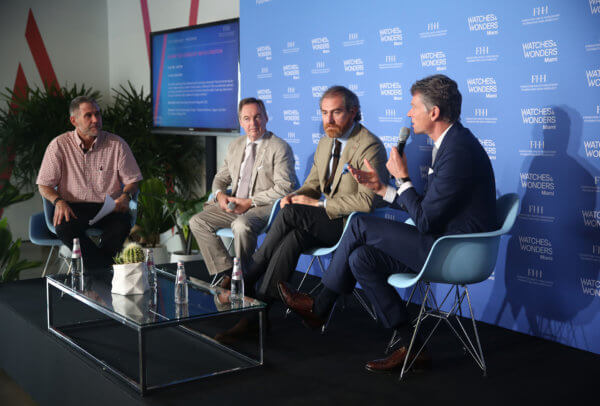Speakers on the panel included Fabrizio Buonamassa, Creative Director of Timepieces at Bulgari for the past 18 years, and a car designer before that; Stephane Belmont, with Jaeger-LeCoultre for the past 20 years and now Director of Heritage for the brand; and Rudy Albers of Wempe USA, a watchmaker and head of the New York retail store for more than 30 years. The panel was moderated by Keith Strandberg of Revolution magazine. Panelists agreed that developing a new watch design that is absolutely on point stems from really knowing the brand, its philosophy and the design codes that have been used in the past in order to plan new looks. “The most important thing for us is the future,” explains Belmont. “Even though we look to the past to understand the consistent design codes, we always look to the future, too.”
The Italian way
According to Buonamassa, Bulgari’s mission as a jewelry maker and now a watchmaker is to bring its eye for jewelry, color, light and beauty to the forefront in its watches and to find new ways to improve the quality of life for its customers through its products – whether that is an ultra-slim watch or an incredibly chic and complicated one: “We come from creativity in a different way. We have great heritage in jewelry. We are Italian and we are Roman, and that makes us unique in the luxury watchmaking industry. We look at romance, light, proportions. Our Roman history, the Coliseum and the Pantheon have a great impact on our creativity. As a creator, you have to be able to know and manage the heritage, the DNA and know-how of the brand when designing new pieces.”
We have watches that we designed three or four years ago but it wasn’t the right time to release them.
He also offers insight into the timing of new pieces, indicating that even when a brand has created a new line or look, it may not be the right time to roll it out. “You have to have an innovation, whether it’s aesthetic or movement- or material wise. Sometimes, though, you can have the right product and it is not the right moment to unveil it, so you have to wait. In some cases we have watches that we designed three or four years ago but it wasn’t the right time to release them, because maybe the clients were not ready yet. There are many factors to consider.” For these reasons, the brands often look to their top clients and retailers for feedback on the designs to ensure they are on the right track, so to speak. Rudy Albers of Wempe said he frequently gets visits from brand executives and designers who are looking for feedback from customers before a collection goes live. “We get to weigh in on certain aspects of the watch, such as straps, dial colors and aesthetics. The watch is no longer just a provider of time,” says Albers. “It is a piece of jewelry that we love to enjoy and look at; so really the design must speak to the customers.”
Constraints drive creativity
While all panelists agreed that the steps their respective brands take in creating a new watch differ, the essentials are the same. “You must understand the spirit and personality of the collection before you further develop it,” says Belmont. “Then you need to convince the people within the manufacture that the watch will be successful. The designers, watchmakers, finishers are the first filter, and of course we need to get approval from them. You never know how long the process will take.” Buonamassa concurs: “This is the mystery of the creative process. You know when you start but never really know when you’ll finish.” In the case of Bulgari, Buonamassa works closely with CEO Jean-Christophe Babin which, he says, can speed up the creative process as there are fewer layers of management to go through. “Still, from the blank sheet of paper we can spend anything between two weeks and three years.”
In addition to creating a great look and chocking the watch with a good movement, watch designers are still inhibited by constraints of size, or function, or material. All say they embrace the challenge. “Constraints drive creativity. They are what make people willing to work harder, try harder. This is what makes it exciting. People think it is impossible but then they strive to do it,” says Belmont.

In the end, though, the most important thing is to make the product saleable. “When you design, you are not alone, you need a team to transform your sketches into a real product and then you have to sell it. This is the difference between a designer and an artist. When you are an artist, you make an expression of your taste and you don’t care if anyone likes it. It is just for your ego. But if you are a designer, ultimately you have to sell that design. This is why the market and feedback are so important,” says Buonamassa.
When asked what makes a watch an icon, the response was simple. Belmont’s answer was that only time will tell. Albers answered that customers will make the decision based on their buying habits. Buonamassa agreed, saying that you have to have innovation, but in the end the client will determine what is an icon.















